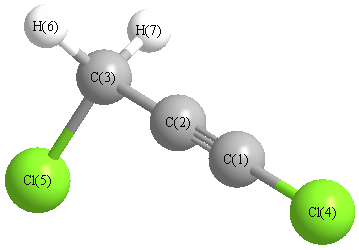Vibrational Frequencies calculated at TPSSh/3-21G
| Mode Number |
Symmetry |
Frequency
(cm-1) |
Scaled Frequency
(cm-1) |
IR Intensities
(km mol-1) |
Raman Act
(Å4/u) |
Dep P |
Dep U |
|---|
| 1 |
A' |
3119 |
3022 |
3.43 |
|
|
|
| 2 |
A' |
2360 |
2286 |
104.62 |
|
|
|
| 3 |
A' |
1517 |
1470 |
1.91 |
|
|
|
| 4 |
A' |
1269 |
1229 |
43.64 |
|
|
|
| 5 |
A' |
1100 |
1066 |
10.43 |
|
|
|
| 6 |
A' |
708 |
686 |
27.49 |
|
|
|
| 7 |
A' |
588 |
569 |
85.48 |
|
|
|
| 8 |
A' |
527 |
510 |
9.84 |
|
|
|
| 9 |
A' |
311 |
302 |
2.00 |
|
|
|
| 10 |
A' |
99 |
96 |
1.56 |
|
|
|
| 11 |
A" |
3185 |
3086 |
0.01 |
|
|
|
| 12 |
A" |
1222 |
1184 |
0.03 |
|
|
|
| 13 |
A" |
888 |
860 |
2.01 |
|
|
|
| 14 |
A" |
557 |
540 |
0.04 |
|
|
|
| 15 |
A" |
203 |
197 |
7.99 |
|
|
|
Unscaled Zero Point Vibrational Energy (zpe) 8827.2 cm
-1
Scaled (by 0.9688) Zero Point Vibrational Energy (zpe) 8551.8 cm
-1
See section
III.C.1 List or set vibrational scaling factors
to change the scale factors used here.
See section
III.C.2
Calculate a vibrational scaling factor for a given set of molecules
to determine the least squares best scaling factor.
Charges, Dipole, Quadrupole and Polarizability
Charges from optimized geometry at TPSSh/3-21G
Charges (e)
| Number |
Element |
Mulliken |
CHELPG |
AIM |
ESP |
| 1 |
C |
-0.283 |
|
|
|
| 2 |
C |
-0.078 |
|
|
|
| 3 |
C |
-0.667 |
|
|
|
| 4 |
Cl |
0.450 |
|
|
|
| 5 |
Cl |
-0.035 |
|
|
|
| 6 |
H |
0.306 |
|
|
|
| 7 |
H |
0.306 |
|
|
|
Electric dipole moments
Electric dipole components in Debye
(What's a Debye? See section
VII.A.3)
| |
x |
y |
z |
Total |
| |
0.895 |
2.109 |
0.000 |
2.291 |
| CHELPG |
|
|
|
|
| AIM |
|
|
|
|
| ESP |
|
|
|
|
Electric Quadrupole moment
Quadrupole components in D Å
Polarizabilities
Components of the polarizability tensor.
Units are
Å
3 (Angstrom cubed)
Change units.
| |
x |
y |
z |
| x |
12.756 |
-0.104 |
0.000 |
| y |
-0.104 |
4.804 |
0.000 |
| z |
0.000 |
0.000 |
2.942 |
<r2> (average value of r
2) Å
2
| <r2> |
315.147 |
| (<r2>)1/2 |
17.752 |
